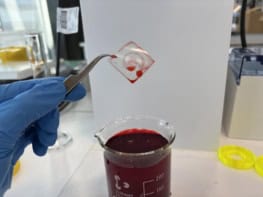
A new technique dubbed surfactant-monolayer-assisted interfacial synthesis (SMAIS) can produce few-layer 2D polymer crystals on the surface of water. This is the first time that researchers have succeeded in making synthetic covalent organic 2D polymer sheets with crystalline domain sizes as large as a few microns. The materials are just a few layers thick and can easily be transferred onto a wide variety of substrates. They might thus be put to use in advanced applications such as membrane separation, electronics, optical devices and energy storage, to name but a few.
Polymers are a sequence of repeat units (monomers) linearly connected through covalent bonds – a definition first proposed by Hermann Staudinger back in the early 1920s. Researchers have been trying to go beyond this concept ever since and synthesize sheet-like polymers with long-range ordering along two orthogonal directions – that is, 2D polymers.
Despite extensive work, the problem with most of the 2D polymers made so far is that they contain crystal domains that are roughly a micron or less in size, which limits the applications in which they can be employed.
Surfactant monolayers as a soft guiding template
A team led by Ute Kaiser and Xinliang Feng of the TU Dresden and Zhikun Zheng at Sun Yat-Sen University, China, is saying that it has now succeeded in synthesizing 2D sheets of polyimide that are highly crystalline and have an average crystal domain size of roughly 3.5 microns.
The researchers made their materials on the surface of water by reacting amine and anhydride monomers together. They helped this reaction along using surfactant monolayers as a soft template to guide the supramolecular organization of the monomers and the subsequent 2D polymerization at the air-water interface. The SMAIS technique, as it has been dubbed, can produce 2D polymer films with a surface area of about 50 cm2 and a thickness that can be tuned between 2.6 to 30 nm.
Characterization techniques
Kaiser and colleagues characterized the molecular structure, grain boundaries and edge structures of their films using X-ray scattering and spherical-aberration-corrected high-resolution transmission electron microscopy (AC-HRTEM). They say that the crystalline polymers form thanks to the pre-organization of monomers at the water-surfactant interface. Depending on the nature of its polar head, the surfactant promotes the arrangement of the monomers, and then their polymerization, in either a horizontal or vertical direction with respect to the water surface. For example, a vertical arrangement is seen when the surfactant bears a carboxylic acid group, which anchors amine monomers through a condensation reaction.
The TU Dresden team, reporting its work in Nature Chemistry 10.1038/s41557-019-0327-5 and Nature Communications 10.1038/s41467-019-11921-3, further backed up its analyses with synchrotron grazing-incidence X-ray scattering (Stefan Mannsfeld‘s group did this part of the work) and density-functional tight-binding calculations (Thomas Heine’s team), which provide important insights into the atomic structures of the synthetic 2D polymers.
Dieter Schlüter of ETH Zurich, who was not involved in this work, says that the TEM images of the polymer films are “the most beautiful” he has seen so far and that the new work is a “milestone”.
“Unprecedented level of long-ranging order”
“Using a simple process, Kaiser and colleagues have managed to obtain few layer covalent films that exhibit an unprecedented level of long-ranging order,” he comments. “Since they can resolve grain boundaries by AC-HRTEM with great precision, they now have, in principle, the long-sought possibility of exploring the effect of reaction conditions on the long-rangedness of order in their sheets. This is an important step towards the rational synthesis of 2D polymers and, more generally, organic 2D materials.
“Since the monomers are commercially available, this makes it easier for other laboratories to perform research in this field and explore 2D polymer properties and applications. Indeed, this will also actually be an advantage for our own work in the future.”

Spider silk, bone and wood inspire 3D printed polymers
Last year, Schlüter and his colleagues, together with co-workers in Benjamin King’s group at the University of Nevada Reno reported on monolayer 2D polymers with long-range order that can be made at the air-water interface. They also provided robust high-resolution atomic force microscope (HR-AFM) evidence for this long-range order. The sheets produced can easily be handled and are clearly polymers too (7×7 mm2 in surface area).
Schlüter’s team was unable to obtain HR-TEM images of their samples for the plain and simple reason that organic monolayers unfortunately burn away under the high energy of the electron beam employed in TEM. The new work by Kaiser’s group is thus an important advance in this respect, says Schlüter, even if the “price to pay” here is the fact that multilayers of 2D polymers rather than monolayers need to be used.
“I do believe that they have produced the largest crystalline domains in synthetic covalent organic sheets,” he says. “Our domains were about 0.5 microns in size on average.”



